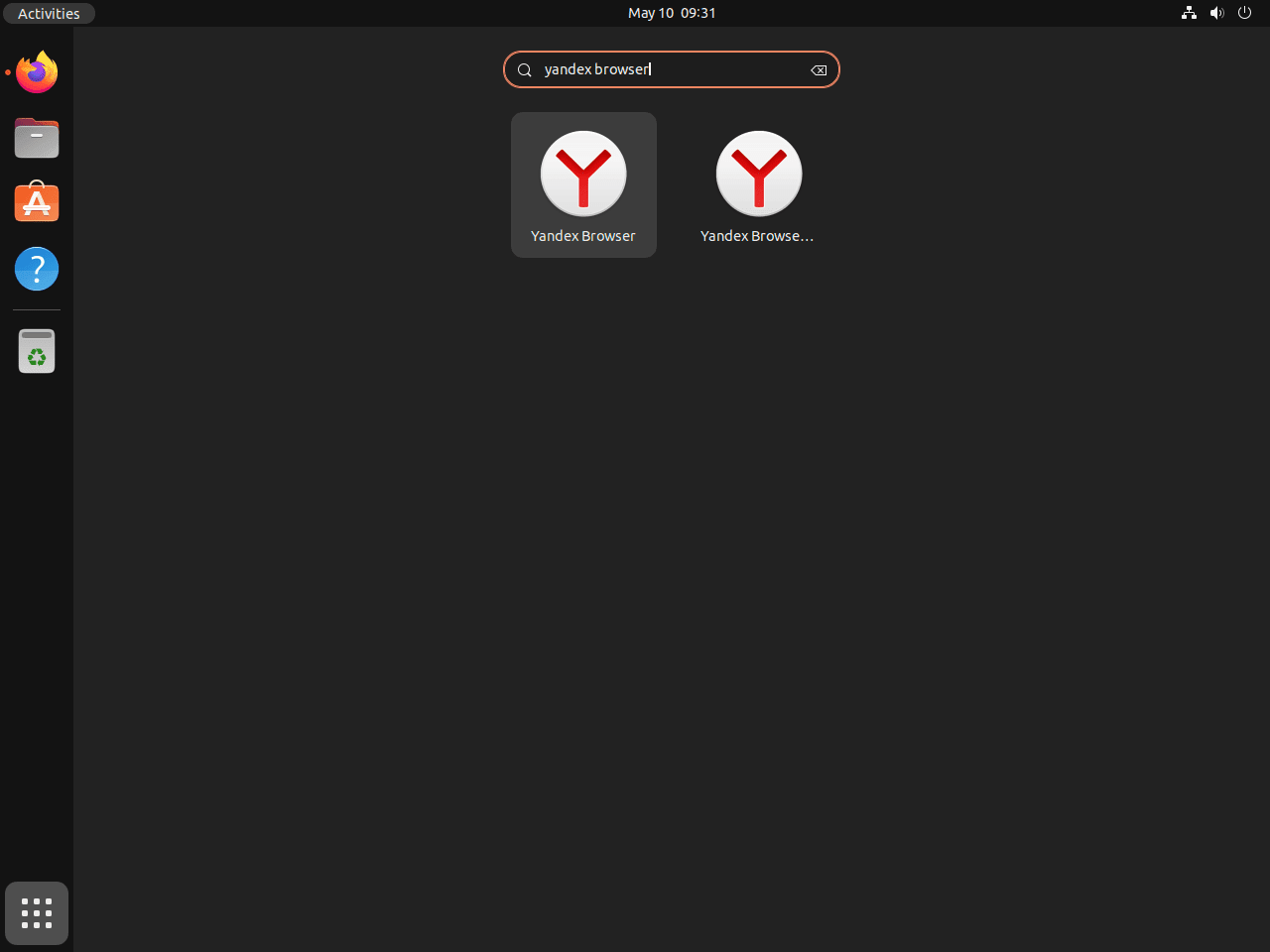Yandex Browser is a fast, secure, and versatile web browser developed by Yandex, a Russian multinational corporation specializing in Internet-related products and services. It features a sleek interface, built-in security tools, and various customization options. Key features include Turbo mode for faster browsing on slow connections, integrated translation tools, and advanced privacy features to protect user data.
To install Yandex Browser on Ubuntu 24.04, 22.04, or 20.04, you can use Yandex’s official APT repository, which provides access to the latest stable or beta builds. This guide will walk you through the steps to add the Yandex repository and install the browser.
Update Your Ubuntu System Before Yandex Browser Installation
Before installing any new software, it’s always wise to ensure that your system is up-to-date. This guarantees the latest features and security updates and mitigates any potential package conflicts during the installation process.
To update your Ubuntu system, you can execute the following command in your terminal:
sudo apt update && sudo apt upgradeThis command will fetch the list of available updates and install them accordingly.
Install Necessary Packages for Yandex Browser Installation
Now that your system is up-to-date, the next step involves installing a set of dependencies essential for successfully installing the Yandex Browser. While most of these packages are likely already present on your system, running the following command will ensure their presence:
sudo apt install curl apt-transport-https -yThis command installs both curl, a tool for transferring data with URLs, and apt-transport-https, a package that allows the package manager to transfer files and data over https. If you encounter issues later in the installation process, you may want to revisit this step to ensure these packages were installed correctly.
Import Yandex Browser APT PPA
We’re ready to import the Yandex Browser Repository with the necessary packages installed. But, before that, it’s necessary to import the GPG key to ensure the authenticity of the packages we’re about to install. This can be done by executing the following command in your terminal:
curl -fSsL https://repo.yandex.ru/yandex-browser/YANDEX-BROWSER-KEY.GPG | sudo gpg --dearmor | sudo tee /usr/share/keyrings/yandex.gpgOnce the GPG key is imported, you can import the Yandex Browser Stable and Beta repositories. Please note that these two share separate installations, and you can choose to import either or both, depending on your preference.
To import the Yandex Browser Stable repository, use the following command:
echo deb [arch=amd64 signed-by=/usr/share/keyrings/yandex.gpg] http://repo.yandex.ru/yandex-browser/deb stable main | sudo tee /etc/apt/sources.list.d/yandex-stable.listTo import the Yandex Browser Beta repository, use the following command:
echo deb [arch=amd64 signed-by=/usr/share/keyrings/yandex.gpg] http://repo.yandex.ru/yandex-browser/deb beta main | sudo tee /etc/apt/sources.list.d/yandex-beta.listRefresh APT Packages List
With the imported Yandex Browser repositories, it’s time to update your package list to reflect the newly imported ones. This can be achieved by running an APT update with the following command:
sudo apt updateFinalize Yandex Browser Installation via APT Command
At this point, your system is ready for the installation of the Yandex Browser. Depending on the repositories you imported, you can install either the stable version or the beta/development version.
To install the stable version of Yandex Browser, execute the following command:
sudo apt install yandex-browser-stableAlternatively, install the beta version of Yandex Browser and use this command instead:
sudo apt install yandex-browser-betaCleaning Up After Yandex Browser Installation
Addressing the Auto-Generated Source.list Issue
When installing the Yandex Browser, whether the stable or beta version, an ancillary sources.list file may be automatically generated. This file, due to improper formatting, can trigger a slew of error messages when executing the apt update command.
Fortunately, there’s a simple solution to this predicament. You can expeditiously remove these extraneous sources.list files with the following command:
sudo rm /etc/apt/sources.list.d/yandex-browser-*.listThis command effectively removes any sources.list files associated with Yandex Browser, regardless of whether you’ve installed the stable or beta version. As such, the command preserves only the sources.list files you imported earlier in this tutorial — namely, yandex-beta.list and yandex-stable.list.
Verifying the Removal of Auto-Generated Source.list Files
Having removed the unnecessary sources.list files, it’s prudent to verify that the operation was successful and that no related errors will occur in future. This verification can be easily achieved by running an apt update.
To update your package list, execute the following command:
sudo apt updateIf the removal was successful, this command should run smoothly without any error messages related to the Yandex Browser. This step effectively confirms that your system is now free of auto-generated sources.list files.
Initiating Yandex Browser via GUI or CLI Methods
Launching Yandex Browser via CLI
You can launch the browser immediately from your command-line terminal with the following command:
yandexGUI Method to Launch Yandex Browser
When you have an expansive array of applications installed on your Ubuntu system, it might be daunting to locate the Yandex Browser manually. However, the intuitive design of Ubuntu’s interface provides an effortless solution:
- Begin by navigating to the Show Applications menu, typically at the bottom-left corner of your screen.
- Here, you’ll find a search bar.
- Type Yandex Browser into this search bar.
- The system will dynamically filter the applications based on your input as you type.
- Once you see the Yandex Browser icon, click it to launch the browser.


Additional Yandex Browser Commands
This section delves into the additional commands associated with the Yandex Browser on Ubuntu Linux. These commands facilitate crucial operations such as updating and uninstalling the browser.
Update Yandex Browser
Updating the Yandex Browser is seamlessly integrated into your routine system update procedure. This means the Yandex repository will be checked concurrently when you check your system for updates. The command you need to run in your terminal is:
sudo apt update && sudo apt upgradeRunning the above command ensures that all your system packages, including the Yandex Browser, are checked for updates and upgraded as necessary.
Uninstalling Yandex Browser
If you ever need to uninstall the Yandex Browser, use the right terminal command for your installed version.
If you have the stable version installed, use the following command:
sudo apt remove yandex-browser-stableIf you are using the beta version, the command to execute is:
sudo apt remove yandex-browser-betaRemoving Yandex Browser Repositories
After uninstalling the Yandex Browser, removing the repositories related to the Yandex Browser from your system is advisable.
The command for removing the stable repository is:
sudo rm /etc/apt/sources.list.d/yandex-stable.listTo remove the beta repository, use:
sudo rm /etc/apt/sources.list.d/yandex-beta.listClosing Thoughts
With Yandex Browser successfully installed on your Ubuntu system, you can enjoy its robust features and enhanced browsing experience. Regularly updating the browser through Yandex’s official APT repository ensures you have access to the latest features and security enhancements. Explore the customizable settings and tools that Yandex Browser offers for a more personalized and secure browsing experience.


Is there a 32-bit version of Yandex for Debian?
No, Yandex Browser does not support a 32-bit version.
please replace “browser-*” to “browser*”:
sudo rm /etc/apt/sources.list.d/yandex-browser-*.list
->
sudo rm /etc/apt/sources.list.d/yandex-browser*.list
thanks for the feedback, fixed.